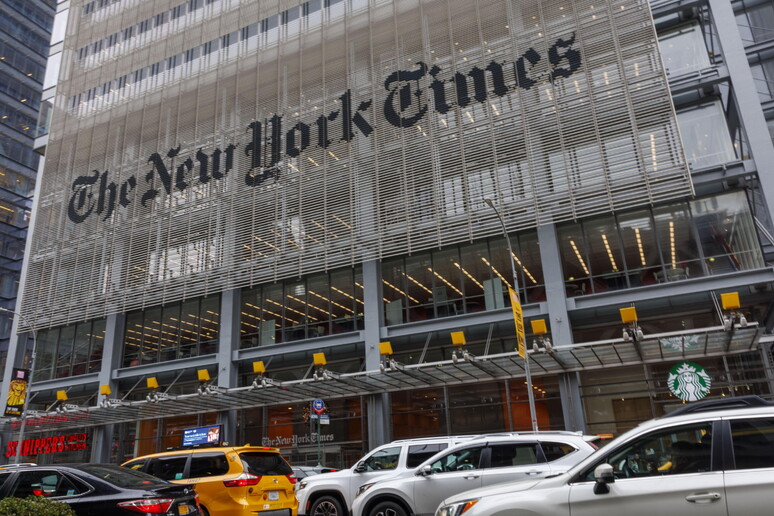As the Democratic mayoral primary draws to a close this weekend, with the last days of early voting before primary day on Tuesday, endorsement pieces published in the New York Times and the Daily News have taken a negative turn. In articles published on June 16th and June 20th respectively, the two pillars of the city’s media landscape focused less on promoting any particular candidate and instead urged New Yorkers to keep one mayoral hopeful off of their ranked-choice ballot: Democratic Socialist Zohran Mamdani, the only candidate within striking distance of frontrunner Andew Cuomo, according to polling.
The Daily News’ headline and accompanying picture announce the editorial board’s endorsement of the former governor, but once one gets to the piece itself, the content is far more anti-Mamdani than pro-Cuomo. The middle section of the article outlining the board’s recommendations for who to place on New York City’s ranked-choice ballot (they endorse Cuomo at the top, Adrienne Adams second, and Brad Lander third) is sandwiched between an introduction and closing section both dedicated to tearing down the Queens Assemblymember, the latter with the cryptic heading “No to Mamdani, more reasons.”
According to the News, Mamdani is “antisemitic” due to his support for the BDS movement, and his views on Israel are “troubling,” even as the country carries out what the vast majority of human rights organizations and relevant scholars have deemed a genocide against Palestinians, and is broadening conflict in the region with a George W. Bush-esque “pre-emptive strike” on Iran. Mamdani’s progressive proposals – like free bus service and a rent freeze – are dismissed as candy-like, in that “they may be attractive and tasty, but it’s not a balanced diet required for a healthy body (politic).” A pithy line perhaps, but one that does not contend with authoritarian and Dickensian turns playing out in the city that Mamdani’s campaign seeks to address.
A full 25% of New Yorkers now live in poverty, nearly double the national rate of 13%, putting the Big Apple in the same league as Rio De Janeiro. New York government reports show that one in five New Yorkers are severely rent burdened, devoting more than 50% of their income to housing. In this environment, what’s surprising is not that Mamdani is focusing his campaign on policies meant to ease the economic pressure on the working class, but that others are not.
That economic pressure is matched with political attacks on the city, as masked ICE agents spirit away undocumented migrants day after day, tearing apart families, and also jail green card holders for exercising very obviously protected rights to free speech. The terrifying crackdown being ratcheted up by the Trump administration and enabled by Mayor Adams gets no mention whatsoever from the News editorial board, even as 40% of New Yorkers are immigrants and 50% live in mixed status households. Despite Cuomo’s claims that he would stand up to the president, the fact that they have a number of donors in common makes that harder to believe.
The New York Times editorial board piece published June 16th on the mayoral candidates is even more puzzling, declaring the race “vexing” in the title and bemoaning a field that “lacks any candidate who seems likely to be the city’s next great mayor.” While the article technically does not declare support for any candidate in particular, following the paper’s announcement last year that there would be no endorsements of local candidates going forward, the board did make one particular recommendation: “we do not believe that Mr. Mamdani deserves a spot on New Yorkers’ ballots.”
Here as well, a considerable amount of negative attention is paid to the upstart candidate, calling his platform “uniquely unsuited to the city’s challenges,” and ridiculing his idea of opening a public alternative to grocery chains – “as if customer service and retail sales were strengths of the public sector.” Like the News’s “candy” line, the scoffing tone distracts from any seriousness the proposal may have, and a number of studies over the years have shown that his idea holds water. With grocery prices 20% higher than pre-pandemic levels and a growing number of New Yorkers being swept into poverty due to rising costs across the board, the Times’s dismissal of a proposal to solve a pressing matter belies their stated sensitivity to affordability issues elsewhere in the piece.
A thread running through both articles is a lack of concern for the rise in economic precarity that has been the central focus of Mamdani’s campaign. The Times disagrees with focusing on a rent freeze rather than increasing supply, even as a report shows growing profits for landlords over the past year. The Daily News called Mamdani’s plan a facile attempt to “repeal the laws of economics,” even though de Blasio did institute a rent freeze three times during his tenure – in 2015, 2016, and 2020 – and while landlords grumbled, the sky did not fall. Neither editorial goes into Cuomo’s policy on housing, which was such an afterthought that the plan put forth by his campaign was written with the aid of ChatGPT.
Cuomo is rightly lauded for some important wins in each piece, namely, health care expansion and the successful completion of construction projects that had stalled under previous gubernatorial administrations. That said, the overwhelming negative sentiment towards Mamdani’s platform, and the dismissive elision of the serious issues he addresses, speaks louder across both pieces.












